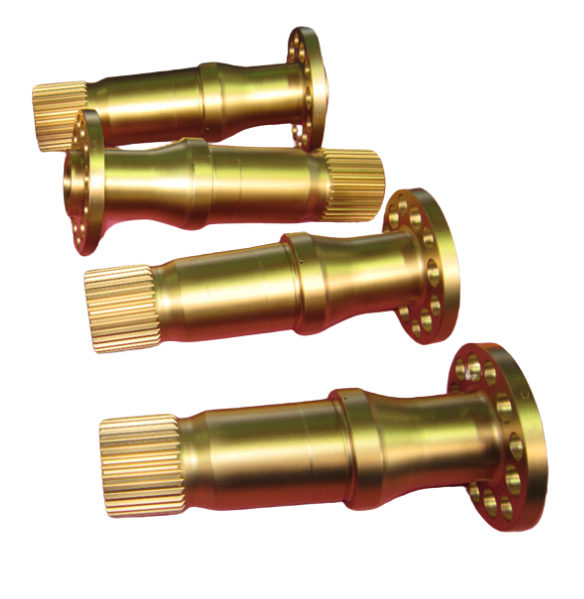posted
On Wednesday, March 20, 2024
in
Blog
Applications of stainless steel (SS) have been known for over a hundred years. Enhancing tribological properties of these alloys can be achieved by using nitriding [1, 2]. However, the standard nitriding process has limited abilities to improve corrosion resistance of SS unless it is used at very low temperatures to produce the expanded austenite phase [2]. This phase is very hard and it has a better corrosion resistance than austenite SS but because it can only be formed at very low temperatures, typically its thickness does not exceed 0.010 mm (0.004”).
The physical properties of titanium are unique and they include low density, low modulus of elasticity, low coefficient of expansion and paramagnetic properties [3]. Titanium offers engineers lower density than steel, higher strength than aluminum and magnesium at all temperatures, and the fatigue, creep, and fracture toughness properties required for aerospace service [3]. In addition to these attractive mechanical and physical properties, titanium and its alloys exhibit resistance to corrosion and erosion from a wide range of industrial chemicals, natural waters, and gases [3]. However, friction/tribological properties of titanium alloys compared to SS are rather poor, and therefore, nitriding is very often used as the main surface treatment for enhancing those properties [4].
To what degree nitrided titanium can replace nitrided SS is a fundamental question, which I will try to answer.
Tribological and Corrosion Properties of Nitrided Titanium Alloys versus Nitrided Stainless Steels
Comparison of the tribological performance of nitrided austenitic and martensitic SS with nitrided titanium alloy is very important, when alternatively, both materials could be used. Linear wear of plasma-nitrided WT3-1 titanium alloy and two plasma-nitrided stainless steels is shown in Fig. 1.
Fig. 1. Linear wear of WT3-1 1H18N9T (austenitic) and H17N2 (martensitic) stainless steels, plasma nitrided
Adapted from E. Rolinski [4, 7].
The linear wear becomes accelerated after approximately 50 min for the H17N2 martensitic stainless steel and after approximately 70 min for the 1H18N9T austenitic stainless steel. The wear of the titanium alloy shows a linear evolution during the whole duration of the test, its value being lower than those of both steels.
Nitrided Titanium Alloy Has Higher Corrosion Resistance than Nitrided Steels
Anodic polarization curves of both steels and titanium alloy are shown in Fig. 2. These curves indicate a markedly higher corrosion resistance of the nitrided titanium alloy relative to that of nitrided steels. It should be noted that the corrosion resistance of stainless steels nitrided at higher temperatures to produce a thick layer diminishes after nitriding [1,2] while titanium alloys do not lose their anticorrosion properties after this treatment.
Fig. 2. Potentiodynamic curves of anodic polarization in 0.05 M Na2SO4 + 0.1 M NaCl solution of pH 3.0 for WT3-1, 1H18N9T (austenitic) and H17N2 (martensitic) stainless steels, plasma nitrided.
SCE, saturated calomel electrode.
Adapted from E. Rolinski [4, 7].
Nitriding Titanium Produces A Gold Color
 It could be noticed that despite preferential treatment of stainless steel at low temperatures, its corrosion resistance is still much lower than that of nitrided titanium alloy. The structure of the nitrided layer in titanium and its alloys always contains TiN nitride at the surface in the first subzone of the layer [4]. Therefore, nitrided titanium products have a very attractive gold color.
It could be noticed that despite preferential treatment of stainless steel at low temperatures, its corrosion resistance is still much lower than that of nitrided titanium alloy. The structure of the nitrided layer in titanium and its alloys always contains TiN nitride at the surface in the first subzone of the layer [4]. Therefore, nitrided titanium products have a very attractive gold color.
Titanium also has excellent acoustic properties and therefore is a prime material for making sonotrodes used in ultrasonic joining as tools for super precise welding and cutting. Nitriding helps to increase the life of such tools [6].
Conclusion: Nitrided Titanium Can Be a Great Substitute for Stainless Steels
Comparative investigations of the properties of plasma-nitrided titanium alloys and alloy steels, shown above, have demonstrated that nitrided titanium alloys can be a substitute for acid-resistant steels in cases where high-contact abrasive wear resistance is required [4, 6-8].
REQUEST A QUOTE
"Titanium Alloys vs Stainless Steel" References
1. E. Rolinski, “Effect of plasma nitriding temperature on surface properties of stainless steel”, Surface Engineering, 3(1987) 35-40.
2. Thermochemical Surface Engineering of Steels, Ed. E. J. Mittemeijer and M. A. J. Somers, Pub. Woodhead Publishing, 2014, pp 413-449.
3. F. H. Froes, editor, “Titanium Physical Metallurgy Processing and Applications” ASM International, 2015.
4. E. Rolinski, “Nitriding of Titanium Alloys”, ASM Handbook, ASM International Vol. 4E, Heat Treating of Nonferrous Alloys, Volume Editor, G. E. Totten, 2016, pp.604-621.
5. E. Rolinski,” Plasma Assisted Nitriding and Nitrocarburizing of Steel and other Ferrous Alloys”, Chapter 11 in Thermochemical Surface Engineering of Steels, Ed. E. J. Mittemeijer and M. A. J. Somers, Pub. Woodhead Publishing, 2014, pp 413-449.
6. E. Rolinski, “Plasma Nitriding of Titanium and Its Alloys,” D.Sc. dissertation, Warsaw University Publications, Warsaw, Poland, 1988, p 1–119 (in Polish).
7. E. Rolinski, “Surface properties of plasma nitrided titanium alloys”, Materials Science and Engineering, 108(1989) 77-44.
8. E. Rolinski, “Isothermal and cyclic plasma nitriding of titanium alloys”, Surface Engineering, 2(1986), 35-42.
- corrosion resistance
- ion nitriding
- nitriding
- stainless steel
- titanium
- wear resistance